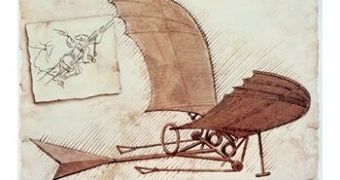Is it a bird? Is it a plane? Is it Superman? Nope, it's a bird-plane!
What is a bird-plane, you say? It's a futuristic plane concept created by a small research team, that will fly just like a bird. It will Arch its broad wings up and then flap them down in one continuous, fluid motion. No turbines or propellers, no flaps or rudders, will interrupt the smooth surface of the plane's flattened body.
It's called the solid-state aircraft.
Flying like a bird was man's dream ever since he started wondering why and how do birds fly, and many people, famous or not, have tried to design flying machines inspired by the flapping wings of birds.
In mythology, Icarus was the son of the artificer Daedalus, famous for his death caused by falling into the sea when flying too close to the sun with a pair of man-made wings, built from feathers glued together with wax, which melted from the heat.
Leonardo da Vinci, fascinated by the phenomenon of flight, produced detailed studies of the flight of birds, and plans for several flying machines, including a helicopter powered by four men (which would not have worked since the body of the craft would have rotated) and a light hang glider that could have flown. On January the 3rd, 1496 he unsuccessfully tested a flying machine he had constructed.
The MIT Daedalus was a human-powered aircraft which, on April 23rd, 1988 flew 74 miles (119 km) from the Iraklion Air Force Base on Crete, crashing in the sea just near the island of Santorini in 3 hours, 54 minutes. Despite the fact that the aircraft crashed short of its goal, the flight holds official FAI world records for distance and duration for human powered airplanes. The records stand to this day.
Now, a group of aerospace engineers, led by Anthony Colozza, have been working on the project of the mobile wing plane for the past seven years with funding from the NASA Institute for Advanced Concepts; they have completed a feasibility study and worked out an initial design - and even some functional, if crude, proof-of-principle demonstrators.
But why fly like a bird? Colozza says energy efficiency is the main reason. The solid-state aircraft will fly like an albatross, which can glide great distances and circle over the same area for long periods of time, flapping only to regain altitude. Another advantage is control. To maneuver, the solid-state aircraft will adjust its wings into complex shapes, much as birds do, rather than using flaps or other moving surfaces.
"The plane would have many potential applications: gathering scientific data, relaying communications, and surveying terrain are but a few," he writes. Thanks to its flexible body, it could be stowed and then deployed in remote places on Earth or even on other planets whose inhospitable atmospheres would doom air-breathing planes.
The solid-state aircraft could become a reality within a decade or two.

 14 DAY TRIAL //
14 DAY TRIAL //